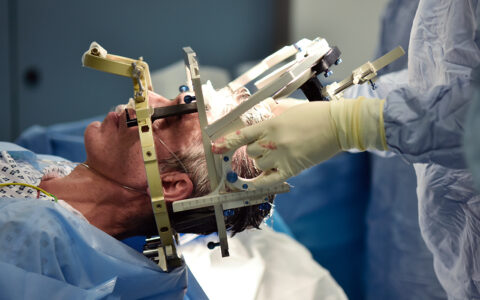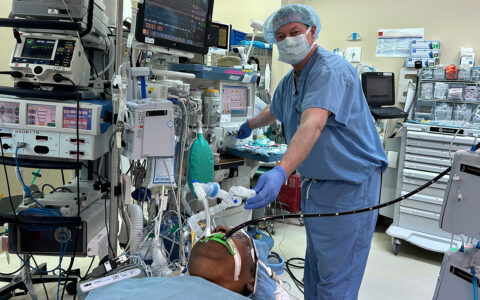Neurofibromatosis (NF) and related disorders are genetic conditions characterized by multiple
birthmarks, benign nerve tumors, and a wide array of less common manifestations including
developmental, neurological, endocrine, skeletal, vascular, and developmental problems. Although many affected people inherit the disorder, between 30 and 50 percent of new cases result from a spontaneous genetic mutation of unknown cause.
The most common form, neurofibromatosis type 1 (NF1), affects about one person in 3,000. NF2, which has a separate genetic profile, typically manifests as bilateral vestibular schwannomas.
“Neurofibromatosis is a broad-spectrum disorder,” said Paul Moots, M.D., co-director of the Neurofibromatosis Clinic at Vanderbilt-Ingram Cancer Center. “At one end of the spectrum, you have severe neurological impairment from childhood on. At the other end, there are a lot of people who neurologically are normal and go on through high school and college to live normal adult lives.”
Promising Treatments
Until the late 1980s, when clinical guidelines were issued, neurofibromatosis was less frequently
diagnosed. A child would present with multiple “café au lait” spots on the skin but might not be
recognized as having NF1 until adolescence or adulthood. Now, most patients are diagnosed in childhood, said Moots. In 10% or so cases, there are unusual or incomplete findings and physicians cannot make a diagnosis without genetic testing, but in most cases, they can recognize the features.
One type of NF-related tumor, plexiform neurofibroma, manifests as often large and very soft internal tumors that cause damage by compressing vital organs or occasionally by transforming into malignancies. “For these,” Moots said, “there have been some exciting new treatment options in chemotherapy. In the past, treatment had largely been partial resection and almost always ineffective, with residual tumor that grew back.”
Newer targeted chemotherapies, including the MEK inhibitor selumetinib, have shown promise in trials
for helping to shrink plexiform neurofibroma tumors. Vanderbilt will be a site in a new trial (NCT03962543) studying a MEK inhibitor. These drugs, Moots said, have been a critical step forward. “There are
also drugs in testing for NF2 that are targeted chemotherapies for vestibular schwannomas and
meningiomas.”
Advances in NF Care
The Vanderbilt Neurofibromatosis Clinic has developed a model of life-long care that treats both adult and pediatric patients. The clinic provides a multidisciplinary resource for NF patients and their families for the assessment and treatment of specific complications through a network of specialists highly experienced in managing NF patients.
Patients are monitored on an annual basis by history and physical exam, and if new symptoms appear, or tumors in critical locations, magnetic resonance imaging (MRI) is used to monitor. Academic development, blood pressure, and spine curvature are other checkpoints.
“We serve as a care hub,” said Moots. “If someone needs neurosurgery, if someone needs orthopaedic surgery, or if someone has severe developmental disabilities and needs medicine or some other treatment, we refer them to the appropriate specialists. Yearly, every child should have a detailed eye exam because of the high incidence of optic nerve tumors, and we often are coordinators for that.”
Genetic Testing and Counseling
Genetic counseling has become a critical factor when treating young adults and families affected
by neurofibromatosis. In both NF1 and NF2, the child of an infected parent has a 50/50 likelihood of
getting the condition. The options for trying to reduce that risk currently have been sperm donation,
adoption, or in vitro fertilization, followed by testing for the gene defect in a set of embryos and
selecting the ones without it.
“That kind of genetic approach has been an improvement and hopeful for some people.”
“That kind of genetic approach has been an improvement and hopeful for some people,” said Moots,
“although technically and financially, as well as emotionally, it’s a real challenge. DNA technologies like
CRISPR (clustered regularly interspaced short palindromic repeats) that can edit abnormal genes are
currently under investigation in laboratory studies, and there are now people looking at those
approaches for NF.”





